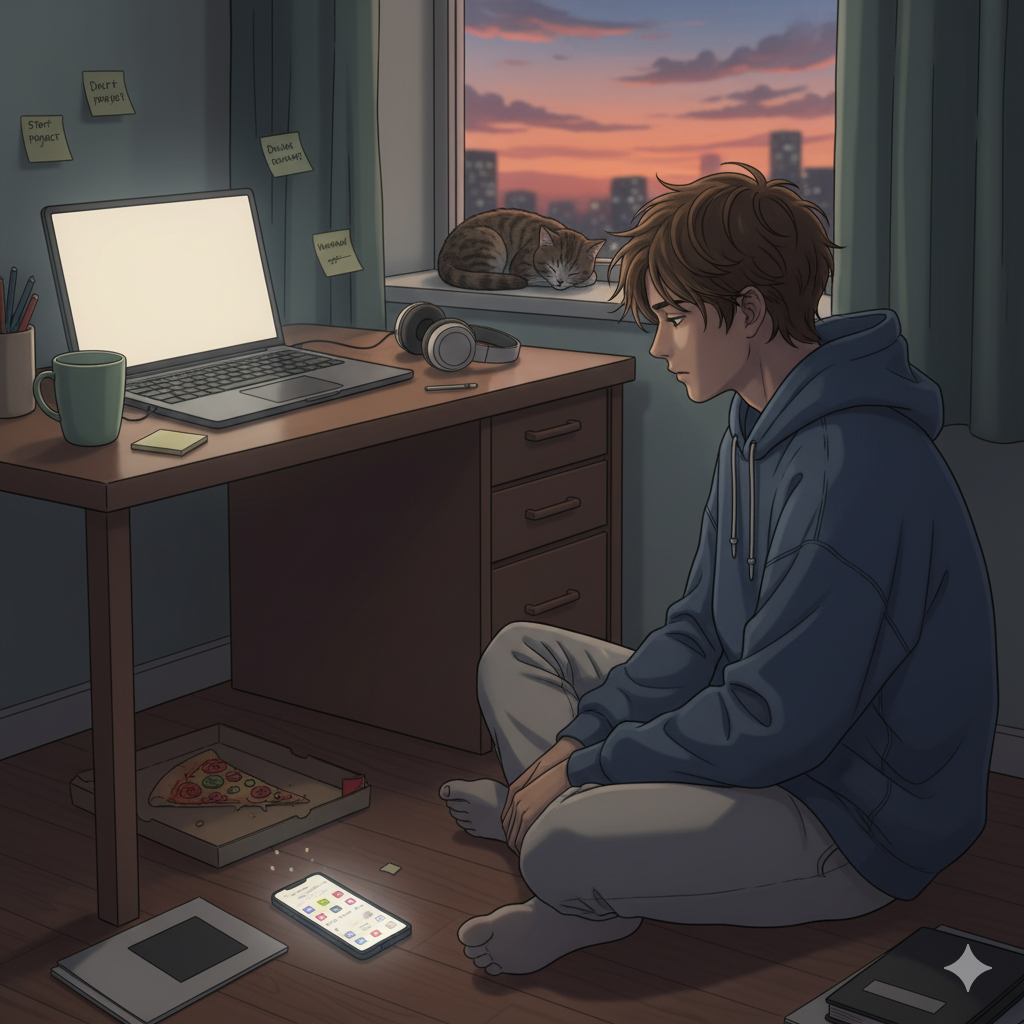Stuck Again? Why You Keep Procrastinating — and How to Break Free in 2025
You open your laptop, promise yourself this time will be different…
You’ll write that report. Finish that course. Start your gym routine.
But five minutes later, you’re scrolling. Again.
It’s not that you don’t care — it’s that your brain is at war with itself. Between dopamine hits from notifications, pressure to be “productive,” and an endless stream of comparison, your focus feels hijacked.
If that sounds like your daily loop, you’re not lazy. You’re simply caught in what psychologists call emotional avoidance — your brain protecting you from discomfort by choosing the short-term relief of delay.
Let’s decode why this happens, and how you can finally stop fighting yourself.

It’s Not Laziness — It’s Your Brain Trying to Protect You
Procrastination isn’t a time problem — it’s an emotion regulation problem.
When you delay something important, your limbic system (the emotional brain) is trying to escape an uncomfortable emotion — fear, boredom, self-doubt — while your prefrontal cortex (the rational planner) tries to stay on track.
The limbic system often wins.
In a neurocomputational fMRI study, researchers modeled procrastination decisions and found that the brain discounts the expected effort cost more when a task is delayed, making “later” look easier than “now.”
Hidden Traps That Keep You Stuck in the Same Loop
“What If It’s Not Good Enough?” — The Fear That Freezes You
You open that assignment but freeze — “What if it’s not good enough?”
Your brain links starting with possible shame. So it waits.
🧠 Why: The amygdala, your brain’s fear center, fires up. Instead of facing uncertainty, you protect your self-worth by delaying.
💡 Fix: Start imperfectly on purpose. Tell yourself, “I’m just opening the file for 2 minutes.” Small exposure reduces the emotional weight.
Over time, your brain learns that starting isn’t dangerous.
Too Many Choices, Zero Action — The Paralysis of Overthinking
You have 10 things to do and can’t decide where to start. So you end up doing… nothing.
🧠 Why: Each micro-decision (what to study, what to prioritize, when to begin) burns mental energy. When the prefrontal cortex is overloaded, the brain defaults to autopilot — distraction.
💡 Fix: Pre-decide once. Create simple templates:
- Morning = learning tasks
- Afternoon = creative tasks
- Evening = light admin
The fewer choices you make, the more focus you save.
Dopamine Hijack: Why You Keep Choosing Shortcuts Over Progress
You plan to study, but one YouTube short later… it’s 11 PM.
🧠 Why: Each swipe releases dopamine — your motivation neurotransmitter. Over time, your brain gets hooked on fast rewards and loses sensitivity to effort-based ones.
💡 Fix: Rewire your dopamine system by adding friction to easy rewards.
- Keep your phone in another room for 30 minutes.
- Delay checking notifications by 10 minutes.
Small digital fasts restore dopamine balance — and your focus.
You’re Not Lazy — You’re Just Unclear
You say you’ll “work on your project,” but what exactly does that mean?
🧠 Why: Vague goals create cognitive resistance. The prefrontal cortex loves precision — it can’t execute on abstractions.
💡 Fix: Turn goals into actions you can visualize:
Instead of “study biology,” say, “read pages 10–20 and summarize key ideas.”
Clarity converts pressure into movement.
When You’re Too Drained to Care — The Hidden Cost of Burnout
You want to work — you just feel drained.
🧠 Why: Chronic stress elevates cortisol, which blocks motivation and focus. When your body feels unsafe or exhausted, your brain prioritizes survival, not progress.
💡 Fix:
- Mini-rests: Take 10 slow breaths before each work block.
- Energy cycles: Do hard tasks in your peak energy hours (for most, mid-morning).
- Be kind: Guilt adds another layer of stress. Compassion restores motivation faster than criticism.
Why Beating Procrastination Is Harder Than Ever in 2025
Our digital age has made procrastination more addictive than ever:
- Short-form content: Platforms engineer dopamine loops every few seconds.
- AI assistance paradox: Too many tools make you wait to feel ready instead of acting.
- Over-optimization culture: You’re told to plan perfectly, track everything, and be “efficient” — until you burn out before starting.
🎯 Reality check: You don’t need more tools. You need fewer obstacles between intention and action.
How to Finally Take Action (Even When You Don’t Feel Ready)
Here’s a simple, science-based system to help your brain move from avoidance to action — without forcing motivation.
Step 1: Rewire Your Dopamine
- Delay easy pleasures (music, scrolling) by 15 minutes after finishing one task.
- Use “dopamine anchors”: pair focus with small rewards like sunlight, tea, or short walks.
Step 2: Shift to Identity-Based Goals
Stop saying “I need to study.”
Start saying, “I’m the kind of person who learns daily.”
Identity goals reduce internal resistance — your brain seeks consistency with who you believe you are.
Step 3: Use the 2-Minute Activation Rule
If it takes less than two minutes, start it now.
Often, motivation follows action, not the other way around.
Step 4: Time-Box Your Focus
Work in 25–40 minute sprints with a timer, then take a 5-minute reset.
This reduces the emotional “weight” of big tasks and builds momentum.
Step 5: Build Gentle Self-Compassion
Every delay is data, not failure.
Ask: “What emotion am I trying to avoid?”
When you name it, you regain control.
You’re Not Broken — You Just Need a Better System
Procrastination isn’t about willpower — it’s about self-understanding.
At Healthun, we help you decode your mind and body through personalized guidance, so you can align your lifestyle, focus, and energy naturally.
Because becoming your best self doesn’t start with pressure.
It starts with clarity, compassion, and small, consistent wins.
The Moment You Stop Waiting for the Perfect Moment
What if you stopped waiting for the perfect moment — and began imperfectly today?
You don’t need to fix everything.
You just need to move — once — and let momentum build the rest.
Your brain is wired to protect you. Now it’s time to teach it to trust you.
📚 Scientific Reference:
Le Bouc R, Pessiglione M. A neuro-computational account of procrastination behavior. Nat Commun. 2022 Sep 26;13(1):5639. doi: 10.1038/s41467-022-33119-w. Erratum in: Nat Commun. 2022 Oct 21;13(1):6252. doi: 10.1038/s41467-022-34142-7. PMID: 36163352; PMCID: PMC9513091.

